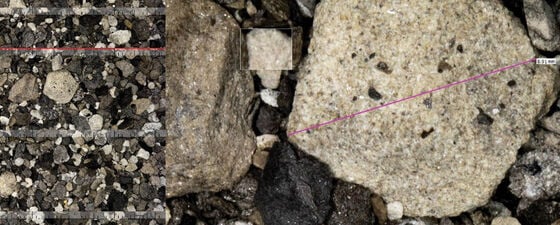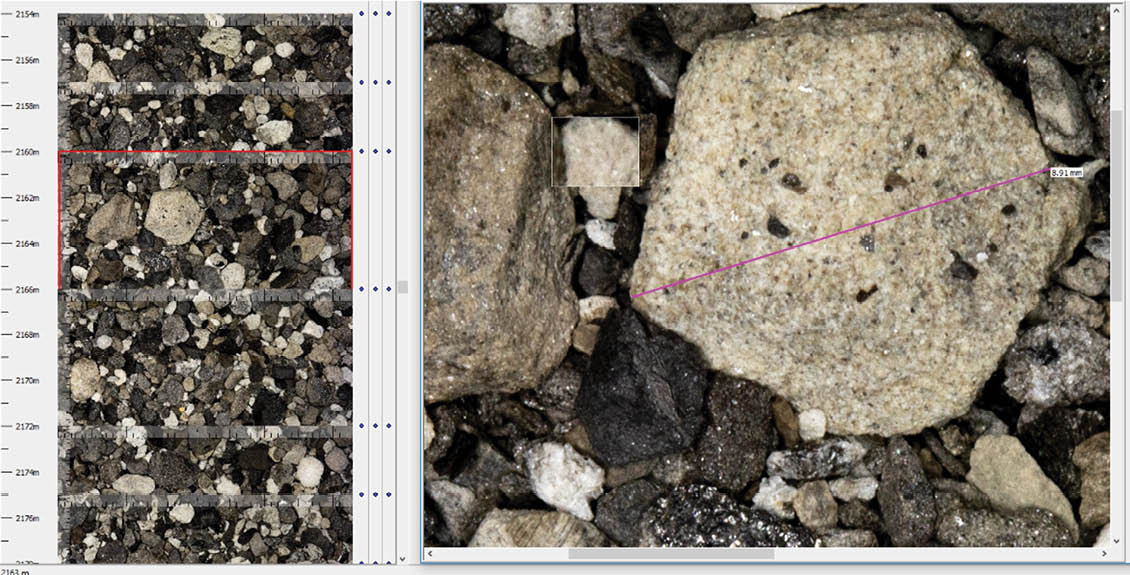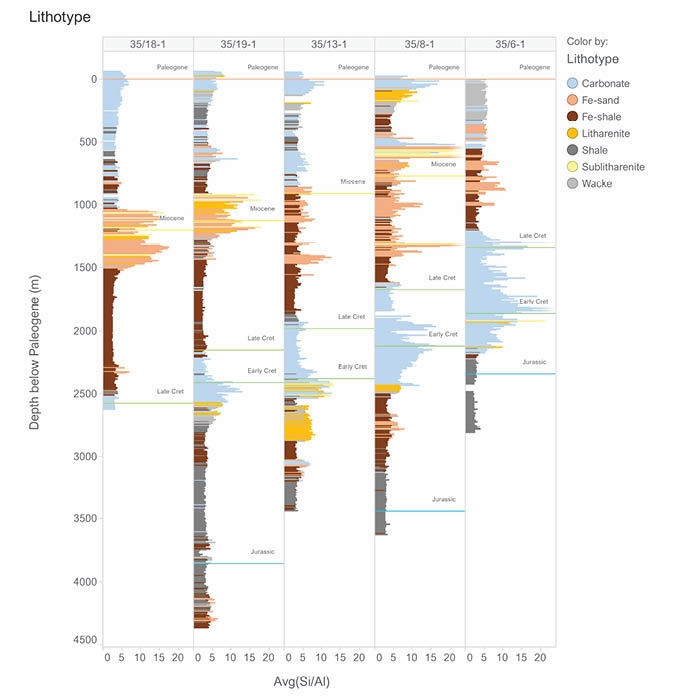Around the world, there are millions of drill cuttings samples from thousands of oil and gas wells lying dormant in warehouses and core repositories. These samples often remain unwashed and inconvenient to access. However, growing recognition of the untapped value of these samples is changing the attitude towards cuttings and there is now real momentum behind the concept of digitalising entire national archives.
Unwashed cuttings samples are generally placed in bags and boxes at the rig site and, in many cases, never see the light of day again. Washed and dried sets are sometimes available, but volumes can be depleted in key stratigraphic intervals, which need to be replenished through the washing of remaining unwashed material. Innovative technology is now being employed to digitalise samples from legacy wells at scale and, in doing so, make cuttings data more accessible to geoscientists at remote workstations. Before digital data can be generated, each sample must be logged and cleaned effectively (Figure 1a and b). Only once drilling fluids and contaminants have been removed can the sample be subject to further analytical techniques.
Unlike other subsurface rock samples, cuttings are almost always available in vast quantities and provide information about the majority of the stratigraphic section. These qualities mean that digitalised cuttings data are well-suited for training machine learning models with potential for use in both supervised and unsupervised models. In the supervised scenario, a properly labelled database can be coupled with image segmentation and careful integration of elemental X-Ray Fluorescence Spectroscopy (XRF) data to provide lithological predictions and interpretations for thousands of samples at a time. However, the results of any computer-driven analyses are only as good as the input data and therefore consistency in sample preparation and analytical procedures is paramount.
From Old Wells to National Archives
A breakthrough in sample preparation emerged in 2010 when a methodology and apparatus for the automated washing and drying of cuttings samples was developed by Rockwash Geodata. Initially, the demand for cuttings to be washed at scale was to feed further analytical techniques such as Fluid Inclusion Stratigraphy, but it soon became clear that, as thousands of samples were being processed systematically, there was a golden opportunity to generate layers of additional data.
After several years of refining the procedure, the standardised digitalisation workflow today includes sub-sampling and logging, automated sample washing and drying, high-resolution cuttings photography and the analysis of a sample’s constituent chemical elements using XRF. Consideration is given to maintaining an entirely non-destructive process, maximising the volume of cleaned rock material that is then re-bagged, ready for further analysis, while the digital data is stored in a database. All raw data is subject to a rigorous quality control process to ensure total consistency, making it possible to compare from well-to-well and vintage-to-vintage. This includes a careful colour calibration process to facilitate an easier distinction between different lithologies.
In many cases, geoscientists are burdened with enormous datasets that undoubtedly hold value, but without the correct tools are difficult to exploit. Once an entire well of cuttings samples is digitalised, the user must be able to digest it using visualisation software. Depending on the specific technical objective, the user must be able to interrogate grain-scale features within individual samples, whilst also having the option to compare basin-scale variability (Figures 2 and 3).
Since this workflow was established, Rockwash has endeavoured to employ these methods on a national scale, having generated large, digitalised cuttings databases in countries and regions such as Ireland, Atlantic Canada and North Slope Alaska. Globally, the governmental organisations who take responsibility for national rock archives work tirelessly to both preserve and add incremental value to the samples in their custody. Historically, a lot of resources have been allocated to the digitalisation of core and thin sections, successfully connecting geoscientists to this vital information regardless of their proximity to the rock itself. That leaves cuttings as the last frontier of subsurface rock digitalisation. With renewed interest in their suitability for exciting new machine learning methodologies and a greater focus on bringing all data types into a seamless digital environment, it is expected that more large-scale cuttings digitalisation projects will commence worldwide.
Every Sample, Every Well: The NOROG Released Wells Initiative, Norway
Understanding this concept fully, Norwegian industry body Norsk Olje & Gass (NOROG) decided in 2019 to commit to digitalising their full national cuttings archive in a landmark project, commonly referred to as the ‘Released Wells Initiative’, that represents the first of its scope and scale being carried out worldwide.
Having delivered many similar projects of a lesser scale at both the Norwegian Petroleum Directorate (NPD) and with individual Norwegian companies, Rockwash was awarded the contract to generate this database alongside Joint Venture partners, Stratum Reservoir.
Still ongoing, the project’s objective is to wash and digitalise each cuttings sample from every exploration and appraisal well drilled on the Norwegian Continental Shelf, ultimately providing a vast repository of cuttings-derived data that will be available for public access.
The scope of work currently consists of more than 700,000 samples from approximately 1,900 wells. Every sample is subject to the aforementioned standardised digitalisation workflow, with selected additional analytical techniques being performed on 5% of the samples. The additional techniques include Infra-Red Spectrometry (performed by Spectra-Map), X-ray Diffraction (XRD), Total Organic Carbon (TOC) and quantitative electron microscopy (QEMSCAM) (performed by Rocktype). With an eye on developing a database free of any geological bias, the decision was taken to perform these additional analyses only on every sample from the most recently drilled 75 wells, rather than maintaining sole focus on the traditional reservoirs or key intervals.
The project is scheduled for completion in the spring of 2022. To date (August 2021), more than 500,000 samples from Norway have been processed and over 2 million files have been uploaded to the Norwegian national data depository, the DISKOS database (Figure 4).
The pro-active approach that NOROG has taken with this project won it the Exploration Innovation Prize at the NCS Exploration Conference, 2021. Now with a critical mass of data, there is a strong appetite within the Norwegian geoscience community to continue carrying out these digitalisation techniques as a standard on future exploration and appraisal wells to keep supplementing and improving the national database.
A Database for The Energy Transition
In addition to the suitability of digital cuttings data for computer-driven models, there are of course applications in a more traditional geological evaluation. Combining the ability to remotely visualise all the rock in a well with detailed downhole chemical profiles offers insights into a range of subsurface problems including sediment provenance, the preservation of organic matter and reservoir heterogeneity, to name but a few (Figure 5). When available on a regional scale, E&P companies are obvious beneficiaries, but these datasets are also beginning to garner interest in other growing subsurface industries including the CO2 and H2 storage sectors.
Not only do decades of hydrocarbon exploration offer great resources and expertise to those tackling this challenge, there is also a wealth of available samples and data from legacy oil and gas wells that can be used to leverage the risk of any given storage project. With various candidate storage sites being touted in saline aquifers and reservoirs that would traditionally be considered the ‘overburden’, many of these geological intervals have not been cored or comprehensively studied.
Moreover, with a key geological risk factor being the leakage of injected CO2 into overlying groundwaters and beyond, it is imperative to understand the quality and integrity of the seal, as well as the chemical interactions that will take place at the reservoir-seal interface once exposed to CO2 and more acidic CO2-rich pore fluids. It will also be crucial to understand the parent mineralogy of the storage reservoir to be able to assess its viability for effective sequestration of CO2 in precipitating carbonate minerals such as dawsonite and ankerite.
As the need to reduce greenhouse gas emissions becomes more urgent, there is an obligation to strain every technological sinew to meet the challenge. In the context of the energy transition, cuttings from historical oil and gas wells are residual resources that can and should be exploited to propel advances in new industries, wherever possible. Geoscientists working on CO2 storage projects in Norway are being encouraged to use data generated by the NOROG Released Wells Initiative, which is the correct and pragmatic thing to do.
The example being set by the Norwegian geoscience community offers a platform on which other ambitious national cuttings digitalisation projects can be imagined. Greater efforts to do so will ultimately preserve finite and important geological resources, allowing us to address the geological challenges of present and future generations.










